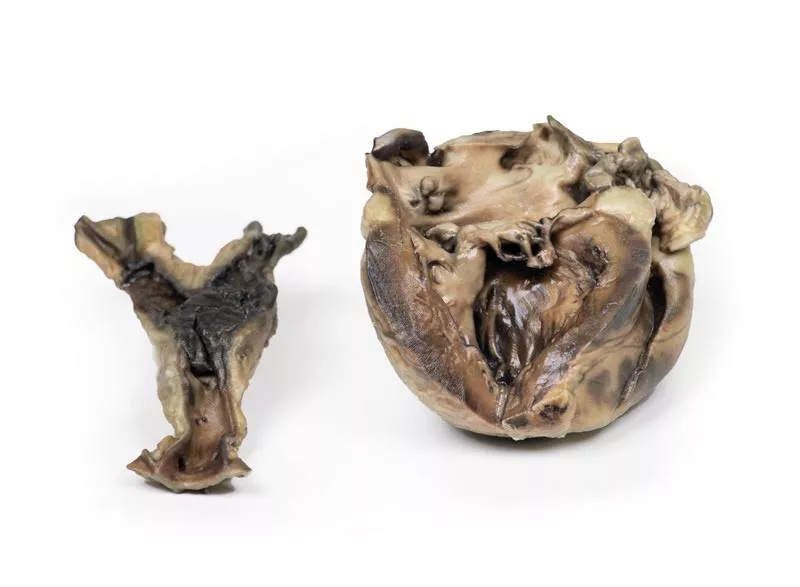Produktinformationen "Congenital Pulmonary Stenosis"
Klinische Vorgeschichte
Bei diesem männlichen Kind wurde direkt nach der Geburt ein Herzgeräusch festgestellt. Bis zum 10. Lebensmonat blieb es jedoch unauffällig. Zwei Wochen vor der Krankenhauseinweisung wurde das Kind zunehmend schlapp, bekam leichten Husten und nahm schnell an Gewicht zu. Zehn Tage vor der Aufnahme kam es zu Schwellungen an Gesicht, Händen und Füßen. Bei der Untersuchung war das Kind aufgedunsen, der Blutdruck betrug 90/59 mmHg. Ein feines Schwirren war über dem gesamten Herzbereich zu spüren, das systolische Geräusch war am lautesten im Bereich der Pulmonalklappe. Es bestanden Ödeme an Gesicht und Beinen. Trotz Behandlung kam es zu keiner Besserung, das Kind verstarb an Herzinsuffizienz.
Pathologie
Das Präparat zeigt das Herz des Kindes in linker Ansicht. Die Pulmonalarterie ist eröffnet und zeigt eine verdickte, konische Pulmonalklappe mit nur 2 mm großer Öffnung. Es besteht eine deutliche poststenotische Erweiterung der Arterie. Das Herz ist auf der rechten Seite stark vergrößert mit einer ausgeprägten Erweiterung des rechten Vorhofs sowie einer rechtsventrikulären Hypertrophie. Es handelt sich um eine isolierte pulmonale Klappenstenose.
Weitere Informationen
Etwa 7?% aller angeborenen Herzfehler entfallen auf die Pulmonalstenose. Sie kann isoliert oder Teil komplexerer Fehlbildungen wie der Fallot-Tetralogie sein. Der Schweregrad reicht von mild bis schwer. Während milde Formen oft unbemerkt bleiben, können mittelschwere Formen rasch fortschreiten. Eine schwere Stenose führt zu erhöhtem Druck im rechten Herzen, Hypertrophie und letztlich zu Herzinsuffizienz. Weitere Komplikationen sind infektiöse Endokarditis und Herzrhythmusstörungen infolge von Narbenbildung. Die Diagnose erfolgt meist mittels Echokardiografie, weitere Bildgebung kann per MRT oder CT erfolgen. Eine chirurgische Korrektur ist heute gut möglich.
Bei diesem männlichen Kind wurde direkt nach der Geburt ein Herzgeräusch festgestellt. Bis zum 10. Lebensmonat blieb es jedoch unauffällig. Zwei Wochen vor der Krankenhauseinweisung wurde das Kind zunehmend schlapp, bekam leichten Husten und nahm schnell an Gewicht zu. Zehn Tage vor der Aufnahme kam es zu Schwellungen an Gesicht, Händen und Füßen. Bei der Untersuchung war das Kind aufgedunsen, der Blutdruck betrug 90/59 mmHg. Ein feines Schwirren war über dem gesamten Herzbereich zu spüren, das systolische Geräusch war am lautesten im Bereich der Pulmonalklappe. Es bestanden Ödeme an Gesicht und Beinen. Trotz Behandlung kam es zu keiner Besserung, das Kind verstarb an Herzinsuffizienz.
Pathologie
Das Präparat zeigt das Herz des Kindes in linker Ansicht. Die Pulmonalarterie ist eröffnet und zeigt eine verdickte, konische Pulmonalklappe mit nur 2 mm großer Öffnung. Es besteht eine deutliche poststenotische Erweiterung der Arterie. Das Herz ist auf der rechten Seite stark vergrößert mit einer ausgeprägten Erweiterung des rechten Vorhofs sowie einer rechtsventrikulären Hypertrophie. Es handelt sich um eine isolierte pulmonale Klappenstenose.
Weitere Informationen
Etwa 7?% aller angeborenen Herzfehler entfallen auf die Pulmonalstenose. Sie kann isoliert oder Teil komplexerer Fehlbildungen wie der Fallot-Tetralogie sein. Der Schweregrad reicht von mild bis schwer. Während milde Formen oft unbemerkt bleiben, können mittelschwere Formen rasch fortschreiten. Eine schwere Stenose führt zu erhöhtem Druck im rechten Herzen, Hypertrophie und letztlich zu Herzinsuffizienz. Weitere Komplikationen sind infektiöse Endokarditis und Herzrhythmusstörungen infolge von Narbenbildung. Die Diagnose erfolgt meist mittels Echokardiografie, weitere Bildgebung kann per MRT oder CT erfolgen. Eine chirurgische Korrektur ist heute gut möglich.
Erler-Zimmer
Erler-Zimmer GmbH & Co.KG
Hauptstrasse 27
77886 Lauf
Germany
info@erler-zimmer.de
Achtung! Medizinisches Ausbildungsmaterial, kein Spielzeug. Nicht geeignet für Personen unter 14 Jahren.
Attention! Medical training material, not a toy. Not suitable for persons under 14 years of age.






































